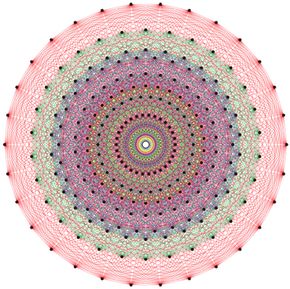Could E8 be the theory of everything?
Lisi is not the first physicist to look to the E8 -- an interrelated 248-dimensional symmetrical object -- as the possible key to the theory of everything. But he's come up with a clever method that may overcome the tricky problem of addinggravityto the mix. Prior to his attempt, physicists generally held that gravity couldn't be expressed mathematically in the same way as electromagnetism and strong and weak nuclear forces could. It's somewhat like combining paragraphs of Mandarin Chinese and Spanish and attempting to translate the resulting document into English using only an English-Spanish dictionary.
But Lisi had heard about a mathematical way of expressing gravity uncovered in 1977, calledMacDowell-Mansouri gravity. He used this method to add an English-Mandarin appendix to the dictionary. Using this expression, Lisi can use mathematical expressions to plug gravity into E8, along with electromagnetism, and weak and strong nuclear forces.
Advertisement
All four of the forces in the universe create a distinct effect on all of the most basic subatomic forms of matter -- calledelementary particles. When these particles interact with force carriers (calledbosons), they become different particles. For example, when one of the most basic quantum particles -- thelepton-- encounters a weak-force boson, it becomes aneutrino. A lepton interacting with aphoton(a boson that carries an electromagnetic charge) becomes anelectron. So while there are limited numbers of the most basic particles, when they encounter the different forces, they change to become other, distinct particles. What's more, for every particle, there is an equally distinct anti-particle, for example an anti-quark or anti-neutrino. In total, these make up the elementary particles, and there are 28 of them.
Each of these distinct elementary particles has eight quantum numbers assigned to it, based on the charges each particle has. This brings the number of distinct particles to 224. These numbers helped Lisi make the particles fit into the E8 model. While the E8 is expressed as a 248-dimensional object in one way, it can also be expressed as an eight-dimensional object with 248 symmetries. Lisi used E8 within eight dimensions for his calculations. For the remaining 24 places unfilled by distinct known particles, Lisi used theoretical particles which are yet to be observed.
Take another look at E8, and notice how the lines radiate from each point:
Lisi assigned each of these 248 points to a particle, using the eight numbers based on their charges as coordinates within the eight dimensions. What he found was that, like the symmetries in the E8 group, quantum particles share the same relationship within the symmetrical object. He has hope that he has figured out a way to crack the theory of everything, because when he rotated the E8 filled with the force-influenced (including gravity) quantum particles, he found patterns emerging between particles and forces -- photons interacting with leptons, for example, created electrons. The connections shown within points on the E8 match up to real, known connections between particles in our physical world.
If Lisi's method is proven correct, then evaluating the E8 could show physicists how macro-scale gravity interacts with the other, highly-localized three forces.
But does it really work, and how can a 248-dimensional object be the theory of everything? Read the next page to find out what some critics are saying about Lisi's idea.



